Free printable mixed operations worksheets for Grade 4
Hi there, and welcome to another exciting article! Today, we will discuss free printable mixed operations worksheets for grade 4 students. These worksheets are designed to help your 4th graders master the skills of adding, subtracting, multiplying, and dividing whole numbers and solving word problems involving mixed operations.
If you are looking for some fun and effective ways to practice mixed operations with your kids, you have come to the right place, where you’ll have fun and enjoy while learning.
-
Why mixed operations worksheets are important for Grade 4 students
There are many reasons why mixed operations worksheets are important for Grade 4 students. First, mixed operations prepare 4th graders for more advanced math topics in the future, such as fractions, decimals, algebra, and geometry.
Also, 4th graders will develop their number sense, logical thinking, and problem-solving skills by learning to perform multiple operations with whole numbers. They also learn how to apply the order of operations and arithmetic properties to simplify expressions and equations.
However, you can grasp more of these mixed operations skills by visiting Mathskills4kids.com, which is enriched with fun math worksheets and activities in all grades. Below are some of our Mathskills4kids’ free printable mixed operations worksheets for your 4th graders.
-
BROWSE THE WEBSITE
-
DOWNLOAD FREE WORKSHEETS
-
-
4th GRADE MATH TOPICS
- Number sense
- Addition
- Subtraction
- Multiplication
- Division
- Mixed operations
- Variable expressions
- Functions
- Coordinate plane
- Data and graphs
- Logical reasoning
- Patterns and sequences
- Money math
- Units measurement
- Telling time
- Equivalent fractions
- Compare & order fractions
- Add & subtract fractions with like denominators
- Add & subtract fractions with unlike denominators
- Multiply fractions
- Decimals
- Add and subtract decimals
- Probabilities and statistics
- 2D shapes
- Triangles and quadrilaterals
- Symmetry
- Angles
- 3D shapes
- Geometric measurement
-
-
Comparison word problems with addition and multiplication
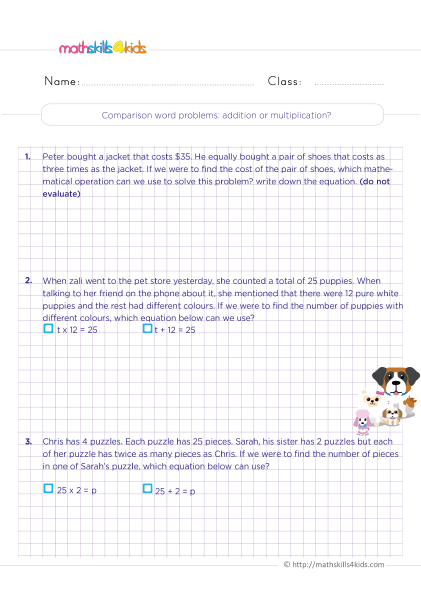 Print it...
Print it...
-
Word problem with extra or missing information
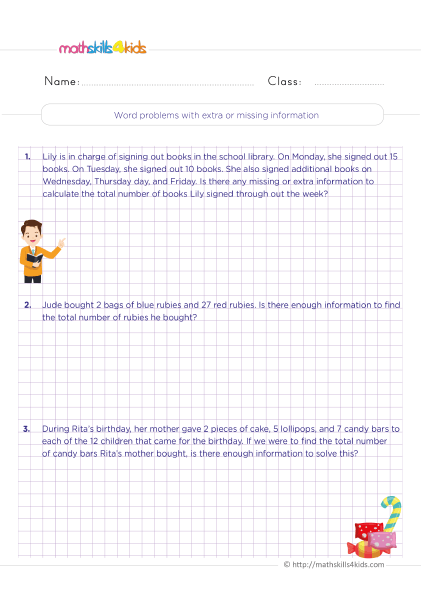 Print it...
Print it...
-
How do you solve multi-step word problems?
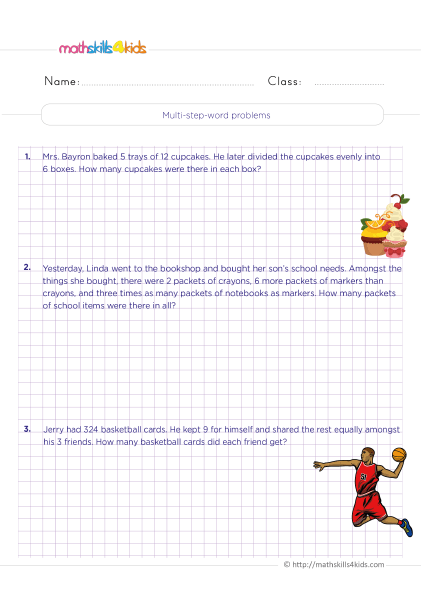 Print it...
Print it...
-
Solving word problems with a particular result practice
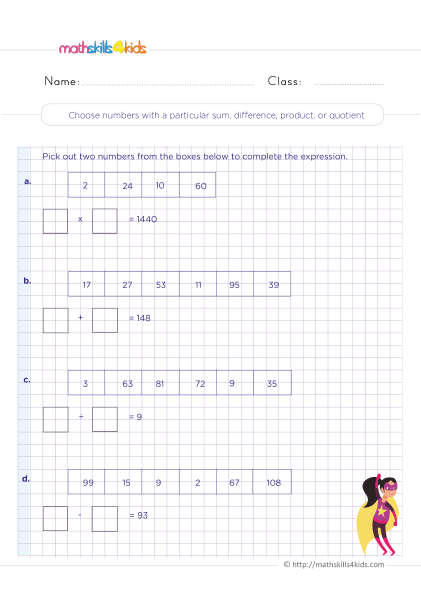 Print it...
Print it...
-
Mentally add and subtract numbers ending with zeroes
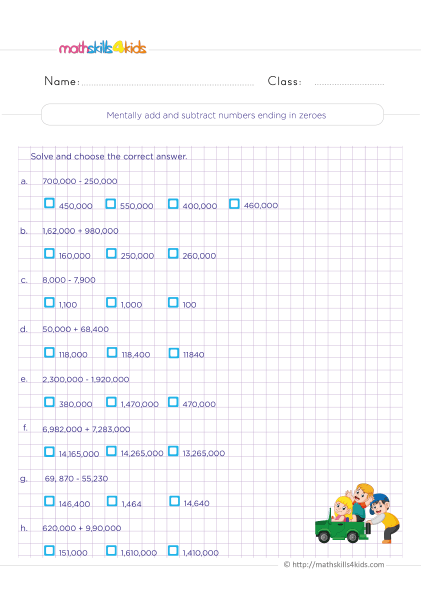 Print it...
Print it...
-
Inequalities involving all 4 operations
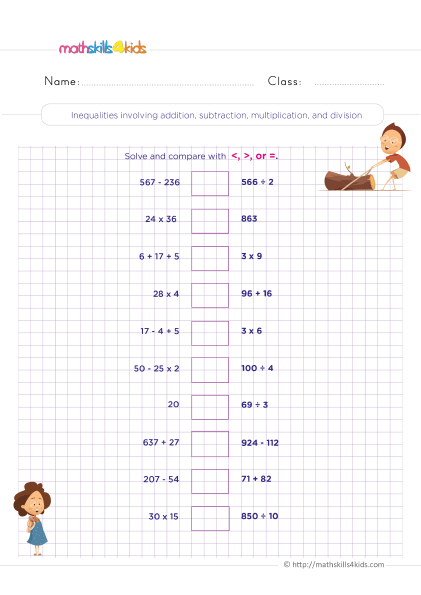 Print it...
Print it...
-
Comparison word problems with addition and multiplication
-
Buying is supporting us!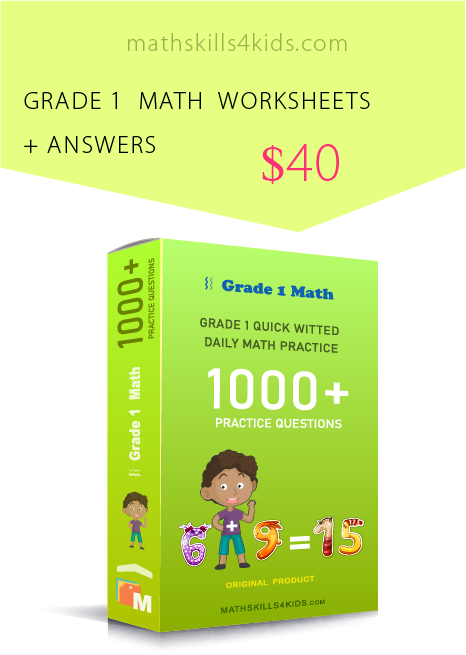
Buy Now...
-
-
What you'll find in Mathskills4kids.com printable mixed operations worksheets
Adding, subtracting, multiplying, and dividing Worksheet
This worksheet covers the basic operations of addition, subtraction, multiplication, and division with whole numbers. It includes a variety of exercises that require 4th graders to perform one or more operations to find the answer. For example:
7 x 8 + 5 =
36 - 9 x 4 =
48 ÷ 6 - 3 =
9 + 6 x 2 ÷ 3 =This worksheet helps 4th graders review and practice the order of operations and arithmetic properties, such as commutative, associative, and distributive. It also helps them improve their mental math and computation skills.
Comparison word problems: Addition or Multiplication?
This worksheet focuses on word problems that involve comparing two quantities using addition or multiplication. For example:
Peter bought a jacket that cost $35. He equally bought a pair of shoes that cost three times as the jacket. If we were to find the cost of the pair of shoes, which mathematical operation can we use to solve this problem? Write down the equation. (Do not evaluate)
This worksheet helps 4th graders understand how to translate words into mathematical expressions and equations. It also helps them choose the appropriate operation to solve the comparison problems.
Estimate sums, differences, products, and quotients: word problems
This worksheet challenges 4th graders to estimate the answers to word problems that involve mixed operations. For example:
Smith owns a large watermelon farm. This year, he sold 621 bags of watermelon. There were 12 watermelons in each bag. To the nearest ten, find out how many watermelons did he sell?
This worksheet helps 4th graders develop their estimation skills and their number sense. It also helps them check the reasonableness of their answers by comparing them with the estimates.
Word problems with extra or missing information
This worksheet tests 4th graders' ability to identify and use relevant information in word problems that involve mixed operations. For example:
- Sam has 15 apples. He gives some apples to his friends and keeps the rest for himself. How many apples does he have left? (Missing information)
- Amy has $20. She buys a book for $12 and a toy for $5. She also sees a beautiful set of gems for a necklace that costs $2 at the shop. How much money does she spend? (Extra information)
This worksheet helps 4th graders improve their critical thinking and problem-solving skills. It also helps them learn how to eliminate unnecessary information and find missing information in word problems.
Solve word problems using guess-and-check
This worksheet introduces 4th graders to a problem-solving strategy called guess-and-check. This strategy involves making a reasonable guess, checking if it works, and adjusting it until it is correct. For example:
Two frogs caught 17 flies in a day’s hunt for food. The smaller frog caught 1 more fly than the big frog. How many flies did each frog catch?
This worksheet helps 4th graders practice using guess-and-check to solve word problems that involve mixed operations. It also helps them learn how to organize their work and show their steps.
Multi-step-word problems
This worksheet presents word problems requiring more than one step or operation to solve. For example:
Bayron baked 5 trays of 12 cupcakes. He later divided the cupcakes evenly into 6 boxes. How many cupcakes were there in each box?
This worksheet helps 4th graders enhance their problem-solving skills and ability to follow multiple steps logically.
Multi-step-word problems: identify reasonable answers
This worksheet asks 4th graders to identify which answers are reasonable for a multi-step word problem involving mixed operations. For example:
Joy’s teacher calls Joy to divide 250,000 by 250 mentally and gives him the answer. Within a short time, Joy told the teacher that the answer was 1,000. Is this answer correct? Why? (Justify your answer)
This worksheet helps 4th graders evaluate their answers and eliminate unreasonable ones. It also helps them check their work and avoid careless mistakes.
Performing multiple operations with whole numbers
This worksheet provides a comprehensive review of all the skills and concepts related to mixed operations with whole numbers. It includes a mix of exercises and word problems that cover all the topics discussed in the previous worksheets. It also includes some challenging questions that require 4th graders to apply their knowledge and skills in new and creative ways.
Solve word problems using guess-and-check
This worksheet introduces 4th graders to a problem-solving strategy called guess-and-check. This strategy involves making a reasonable guess, checking if it works, and adjusting it until it is correct. For example:
Two frogs caught 17 flies in a day’s hunt for food. The smaller frog caught 1 more fly than the big frog. How many flies did each frog catch?
This worksheet helps 4th graders practice using guess-and-check to solve word problems that involve mixed operations. It also helps them learn how to organize their work and show their steps.
-
How to use Mathskills4kids’ free printable mixed operations worksheets for 4th graders effectively
Our Mathskills4kids’ free printable mixed operations worksheets for grade 4 are free to download and print for classroom or classroom use. You can use them as homework assignments, classwork activities, or assessment tools. You can also use them as supplementary materials to reinforce or review the mixed operations lessons taught in school.
To use these worksheets effectively, you should follow these tips:
- Read the instructions carefully to your students and make sure they understand what is being asked.
- Ensure they show their work and ask them to explain their reasoning for each problem too.
- Check their answers using the answer keys provided at the end of each worksheet.
- If your kids get stuck or make a mistake, figure out where they went wrong and how to fix it.
- Let them know that if they need extra help, they can ask you or a friend for guidance.
- Have fun and enjoy learning!
-
Tips and tricks to make mixed operations learning fun and easy
Learning mixed operations can be fun and easy if you use some of these tips and tricks:
- Use manipulatives, such as counters, blocks, or coins, to model the operations and the word problems.
- Use songs, rhymes, or mnemonics to remember the order of operations and arithmetic properties. For example, you can use the acronym PEMDAS (Parentheses, Exponents, Multiplication/Division, Addition/Subtraction) or "Please Excuse My Dear Aunt Sally" to remember the order of operations.
- Use games, puzzles, or riddles to practice mixed operations fun and engagingly. For example, you can play bingo, crossword, or sudoku with mixed operations problems.
- Use real-life examples or scenarios to relate mixed operations to everyday life. For example, you can use mixed operations to plan a party, budget your money, or cook a recipe.
- Use online resources like videos, apps, or websites to learn more about mixed operations and practice them interactively. For example, you can watch Khan Academy videos, use Math Playground apps, or visit Math Is Fun websites.
-
Examples of mixed operations problems and solutions
Here are some examples with detailed explanations to help you understand how to solve mixed operations problems. You can use these examples as models for your practice.
- Example 1: Sam has 12 stickers. He gives 3 stickers to his friend and buys 4 more at the store. How many stickers does Sam have now?
Solution: To solve this problem, we need to use two operations: subtraction and addition. First, we subtract 3 from 12 to find out how many stickers Sam has left after giving some to his friend. Then, we add 4 to that number to determine how many stickers Sam has after buying more at the store.
12 - 3 = 9
9 + 4 = 13
So, Sam has 13 stickers now. - Example 2: Lisa has 15 candies. She wants to share them equally with her 3 friends. How many candies will each person get?
Solution: To solve this problem, we will use one operation: division. We divide 15 by 3 to determine how many candies each person will get.
15 ÷ 3 = 5
So, each person will get 5 candies. - Example 3: Tom has a rectangular garden that is 8 meters long and 6 meters wide. He wants to plant flowers along the perimeter of the garden. How many meters of flowers does he need?
Solution: To solve this problem, we need to use two operations: addition and multiplication. First, we add the garden’s length and width to determine how long one side of the perimeter is. Then, we multiply that number by 2 to find out the total length of the perimeter.
8 + 6 = 14
14 x 2 = 28
So, Tom needs 28 meters of flowers.
- Example 1: Sam has 12 stickers. He gives 3 stickers to his friend and buys 4 more at the store. How many stickers does Sam have now?
-
Review and practice questions with answers
Now that we have seen some examples of mixed operations problems, it's time to test your 4th grader’s skills with some practice questions. Ask them to solve these problems on their own before checking the answers.
Problems
- Ben has a square cake that is 10 centimeters on each side. He cuts it into equal pieces that are 2 centimeters on each side. How many pieces of cake does he have?
- Mia has a jar of coins that contains 50 pennies, 20 nickels, and 10 dimes. How much money does she have in total?
Answers:
To find out how many pieces of cake Ben has, we need to use two operations: multiplication and division. First, we multiply the cake’s length and width to find its area. Then, we divide that area by the area of one piece of cake.
10 x 10 = 100
2 x 2 = 4
100 ÷ 4 = 25
So, Ben has 25 pieces of cake.- To find out how much money Mia has in total, we need to use two operations: multiplication and addition. First, we multiply the number of each coin by its value in cents. Then, we add those amounts together.
50 x 1 = 50
20 x 5 = 100
10 x 10 = 100
50 + 100 + 100 = 250
So, Mia has $2.50 in total.
Bonus: More fun resources to reinforce mixed operations practice for fourth graders
If you want more fun resources to reinforce your fourth grader’s mixed operations practice, here are some pages you can check out:
- https://www.youtube.com/watch?v=WMEHIwyeUY8: This first link is a YouTube video that teaches you how to solve two-step word problems using the four operations. It has clear explanations, examples, and tips to help you master this skill. You can watch it as many times as you want and pause it whenever necessary. It's like having your math tutor!
- https://www.math-drills.com/multiop.php: The second link is a website that generates random worksheets for you to practice the four operations. You can choose the difficulty level, the number of questions, and the type of problem. You can also print them out or do them online. The best part is you can check your answers and get instant feedback!
- https://www.k5learning.com/free-math-worksheets/math-drills/mixed-4-operations: The third link is another website that offers free math worksheets for the four operations. These worksheets are more challenging because they involve mixed operations, meaning that you have to use more than one operation to solve each problem. They also have word problems that test your reading comprehension and problem-solving skills.
- https://www.ixl.com/math/grade-4/two-step-mixed-operation-word-problems: The fourth link is a fun online game that lets you practice two-step mixed-operation word problems. You have to answer as many questions as you can in a given time and earn points. You can also choose the grade level and topic you want to work on. It's a great way to improve your speed and accuracy!
-
Thank you for sharing the links of MathSkills4Kids.com with your loved ones. Your choice is greatly appreciated.
Conclusion: Keep Practicing and Have Fun
Mixed operations are an important skill for fourth graders to master. They help you solve complex problems that involve more than one operation. They also prepare you for higher-level math topics such as fractions, decimals, and algebra.
You can use free printable mixed operations worksheets for Grade 4, word problems, puzzles, games, and other resources to practice mixed operations. You can also use examples and models to solve mixed operations problems.
The more you practice mixed operations, the more confident and proficient you will become. Remember to have fun and enjoy learning!
